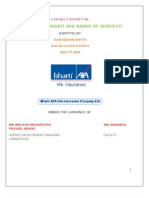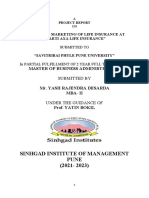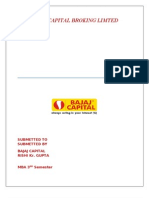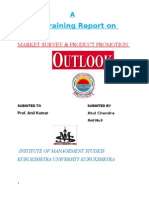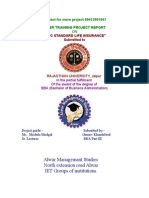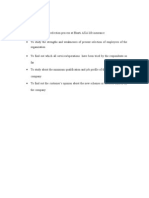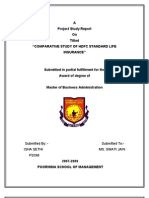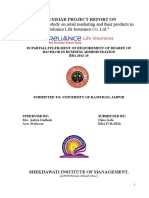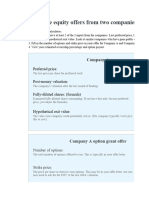Project Report On Bharti Axa
Project Report On Bharti Axa
Uploaded by
avenger_guyCopyright:
Available Formats
Project Report On Bharti Axa
Project Report On Bharti Axa
Uploaded by
avenger_guyOriginal Description:
Original Title
Copyright
Available Formats
Share this document
Did you find this document useful?
Is this content inappropriate?
Copyright:
Available Formats
Project Report On Bharti Axa
Project Report On Bharti Axa
Uploaded by
avenger_guyCopyright:
Available Formats
Working Capital Management of
Bharti AXA
At
Bharti AXA Life Insurance Company Limited
Submitted In Partial Fulfillment of the
Requirements for the Award of the Two Years
Full Time Course in
PGDM 2013-15
By
NI TI L SHARMA
NSHM Business School
NSHM KNOWLEDGE CAMPUS, KOLKATA
124, B.L.SAHA ROAD, KOLKATA 700 053
Page | 1
A SUMMER I NTERNSHI P PROJ ECT REPORT
ON
Working Capital Management of Bharti AXA
AT
Bharti AXA Life Insurance Company Limited
DURATI ON 17
th
J uly TO 31
st
August 2014
UNDER THE GUI DANCE OF
Mr. Piyush Mohan Shukla
(Business Manager Bharti Axa)
&
Mr. Chaman Gupta
(Agency Development Manager- Bharti Axa)
&
Dr. Udayan Kumar Basu
(Faculty Mentor of the I nstitute)
Submitted By
Nitil Sharma
PGDM 2013-15
NSHM Business School, Kolkata
Page | 2
Declaration
I, hereby declare that the research project report titled Working Capital Management of
Bharti AXA is my own original research work and this report has not been submitted to
any University/Institute for the award of any professional degree or diploma.
NITIL SHARMA
PGDM (13-15)
NSHM Business School
Roll No. PGDM13010
Reg. No. 131364002
Page | 3
ACKNOWLEDGEMENT
I wish to express my appreciation to all those with whom I have worked or interacted
and whose thoughts and insights helped me in increasing my knowledge and
understanding my project. It is said, the most important single word is we and the zero
important single word is I, This is true even in todays modern era. It is absolutely
impossible for a single individual to complete the assigned job without help and
assistance from others.
I hereby would like to thank all the members of the office and it is my great pleasure
to acknowledge sincere gratitude towards Mr. Piyush Mohan Shukla (Business
Manager of the Organization) at Bharti AXA Life Insurance Company Limited,
Kolkata who have been extremely helpful and cooperative throughout the process for
the Completion of the project work.
I would also like to owe my sincere gratitude to my project guide Prof. Udayan
Kumar Basu for helping me in this Project work.
Finally, I am thankful to my entire family members for their great support and
encouragement to complete my project in due time and correctly.
Page | 4
Executive Summary
The analysis of Bharti AXA Life Insurance is taken from different sectors.
For creating strong relationship and for a success full business every insurance
company required financial planner.
Page | 5
CONTENTS
Sl. No. Particulars Page No.
Chapter 1 I ntroduction 17 - 29
Chapter 2 I ndustry Overview 17 - 29
Chapter 3 Company Profile 17- 29
Chapter 4 Scope of Study 17- 29
Chapter 5 Research Methodology 30- 32
Chapter 8 Conclusions 33
Chapter 9 Suggestions & Recommendation 33
Chapter 6 Data Analysis, Results & I nterpretation 34
Chapter 7 Observations & Findings 34-41
Chapter 10 Bibliography 42
Page | 6
I NTRODUCTI ON
Insurance Industry in India
With 36 crore policies, India's life insurance sector is the biggest in the world. The sector
consists of 52 insurance companies, of which 24 are in life insurance business and 28 in non-
life. The life insurance industry in the country is projected to increase at a compound annual
growth rate (CAGR) of 12-15 per cent in the next five years. The industry plans to hike
penetration levels to five per cent by 2020, and has the potential to top the US$ 1 trillion
mark over the next seven years.
The optimistic outlook is helped to a large degree by the Government of India's efforts to
strengthen the sector. The Union Cabinet in July approved a proposal to relax foreign direct
investment (FDI) limit in the domestic insurance sector to 49 per cent from 26 per cent,
signaling the government's intent to draw capital and investment into the sector.
The total market size of the insurance sector in India was US$ 66.4 billion in FY 13. It is
projected to touch US$ 350-400 billion by 2020.
India was ranked 10
th
among 147 countries in the life insurance business in FY 13, with a
share of 2.03 per cent. The life insurance premium market expanded at a CAGR of 16.6 per
cent from US$ 11.5 billion to US$ 53.3 billion during FY 03-13. The non-life insurance
premium market also grew at a CAGR of 15.4 per cent in the same period, from US$ 3.1
billion to US$ 13.1 billion.
Digital@Insurance-20X By 2020, by Boston Consulting Group (BCG) and Google India
forecasts that insurance sales from online channels will grow 20 times from present day sales
by 2020, and overall internet influenced sales will touch Rs 300,000-400,000 crore (US$
49.63-66.18 billion).
Investment corpus in India's pension sector is projected to cross US$ 1 trillion by 2025,
following the passage of the Pension Fund Regulatory and Development Authority (PFRDA)
Act 2013, as per a joint report by CII-EY on Pensions Business in India.
Page | 7
Bharti AXA Life
Bharti AXA Life is a life Insurance player that was started in 2006. It brings together strong
financial expertise of the Paris-headquartered AXA Group and Bharti Enterprises - one of
India's leading business groups with interests in telecom, agricultural business, financial
services, and retail. The joint venture has a 74% stake from Bharti and 26% stake from AXA
.The company launched national operations in December 2006. Today, Bharti AXA Life has
a national footprint of distributors trained to provide quality financial advice and insurance
solutions to the large Indian customer base.
Bharti AXA Life offers a range of innovative products and services that cater to specific
insurance and wealth management needs of customers
Bharti Enterprises
Bharti Enterprises is one of Indias leading business groups with interests in telecom, agri
business, financial services, retail and manufacturing. Bharti has been a pioneering force in
the Indian telecom sector with many firsts and innovations to its credit. Bharti Airtel Limited,
the group's flagship company, is a leading global telecommunications company with
operations in 20 countries across Asia and Africa. The Company ranks amongst the top four
mobile service providers globally in terms of subscribers.
Other business ventures of the group include Bharti Softbank - a JV between Bharti
Enterprises and Softbank Corp - for mobile internet. Beetel Teletech, a group company, is
Indias leading manufacturer and distributor of telecom and allied products. The group has a
JV FieldFresh Foods with Del Monte Pacific Ltd, to offer fresh and processed fruits and
vegetables in the domestic as well as international markets. Bharti has JVs with AXA, world
leader in financial protection and wealth management, for Life Insurance and General
Insurance. The group has presence in the retail sector through Bharti Retail while operates
multi brand retail stores in various formats under the 'easyday' brand.
AXA Group
AXA Group is a worldwide leader in Financial Protection. AXAs operations are diverse
geographically, with major operations in Europe, North America and the Asia/Pacific area. In
2010, total revenues amounted to Euro 91 billion and total revenues underlying earnings to
Euro 3.9 billion.
Page | 8
Core Attitudes
These are the three attitudes that clients most expect from an insurance and financial services
company in exchange for their vote of confidence. These three attitudes stood out from the
others in the consumer research we conducted across markets, regardless of their level of
maturity.
They are at the heart of our actions and our commitments to clients.
Vision and Values
Page | 9
Strategy
To achieve a market position among the top 5 in India through a multi-distribution,
multi-product platform
To adapt AXA's best practice blueprints as a sound platform for efficient and profitable
growth
To leverage Bharti's local knowledge, infrastructure and customer base
To deliver high levels of shareholder return
To build long term value with our business partners by enhancing the proposition to their
customers
To be the employer of choice to attract and retain the best talent in India
To be recognised as being close and qualified by our customers.
Strategic Differentiators
A strong parentage of AXA and Bharti, both having long term commitment to the Indian
Insurance market supporting a strong capital solvency
o AXA, a global leader is world's No.1 insurer brand with strong presence in 57
countries
o Bharti is one of Indias leading and trusted business group with strong distribution
capabilities
Global scale of AXA provides cost effective and speedy re-use of systems, products and
business capability resulting in local competitive advantage
o Product: Wealth management, protection and retirement solutions that meets the
needs of customers across segments
o Service: Best-in-class service guarantee at various points of customer life cycle
o Training: Robust learning and development architecture for employees and
distributors focused on superior service delivery and transparent dealing with
customers
o Footprint: Comprehensive pan-India presence through multi-city, multi-channel
setup
o Digital paradigm: Seamless 'Anywhere' product and service experience for
customers and distributors through various e-initiatives (viz. online products,
servicing portals, tablet-based digital advisor, dematerialized policies)
Values and culture of both parents AXA and Bharti along with their strong brand ethos
helps in building trust amongst partners and employees
Page | 10
Sandeep Ghosh is the Chief Executive Officer at Bharti AXA Life Insurance.
He has over 20 years of experience in India and overseas, primarily in
the financial services sector. Prior to joining Bharti AXA Life, he was
with ANZ as the Managing Director, Commercial Banking Head for Asia
Pacific based in Hong Kong. During this time, he played a major role in
building a commercial banking franchise for ANZ in Asia through
organic builds and the integration of businesses acquired from RBS.
Before joining ANZ, Sandeep spearheaded the Commercial Banking for Royal Bank of
Scotland in Asia. He was responsible for Business Banking, SME & Middle Market client
franchises, managing a team of over 1,000 bankers and 40,000 client relationships across 9
countries.
Prior to this, he was with Citibank for 9 years during which he held various roles, lastly as
Managing Director for the Global Commercial Bank in India. During his tenure, he led the
India business to become the largest organically built commercial banking franchise within
Citi.
Products
Term Insurance
Bharti AXA Life eProtect
Bharti AXA Life Elite Secure
Endowment Plan
Bharti AXA Life Secure Savings Plan
Bharti AXA Life Monthly Income + Plan
Bharti AXA Life Flexi Save Plan
Health Plan
Bharti AXA Triple Health Insurance Plan
Money Back Plans
Bharti AXA Secure Income Plan
Bharti AXA Flexi Save Guaranteed Income Plan
Page | 11
Objectives of the study:
1. To study the efficiency of working capital management of the company
2. To know the progress of working capital in a company
3. To study the efficiency of cash, and receivables management of the company
4. To know the solvency of the company & how the company is managing working
capital.
5. The objective of study to analyzed the liquidity position of the company.
6. To study the efficiency of working capital management of the company.
7. To study the efficiency of cash, and receivables management of the company
METHODOLOGY:
The data in this project is enabling in secondary in nature. Financial reports, company
records were referred for data analysis. The study has been undertaken by collecting
relevant data from the balance sheet, profit and loss a/c, Annual Report & Audit
Report of the Bharti Axa Life Insurance Company Limited is used financial as tools
for the analyzing and interpretation data.
However primary data is also collected by observation discussing with company
officials. This primary data is used to fill in the gaps while preparing this report and to
know the latest procedures adopted by the company. This has helped to draw
inferences and conclusions.
Sources of data
There are two types of data
Primary Data
Secondary Data
Primary Data:-
The primary data are those, which are collected fresh for the first
time and thus happen to be original in character. The primary data collection involves
the collecting of information for the first time by observation, experimentation, and
questionnaire and through interview schedules in the original form by the researcher
himself or his nominees.
Page | 12
The primary data was collected through discussion with the finance manager using the
interview schedule. This data was obtained to study the latest procedures relating to
working capital management and ratio analysis system followed by the company
Secondary data:-
The secondary data are those, which have been collected by some other and
which have been processed. Generally speaking secondary data are information,
which have been previously collected by some organization to satisfy his own need.
But the department under reference for an entirely different reason is using it.
I also used secondary sources for collecting the data. They are:
Information from the text sources
Information form the internet sources
Information from the materials provided by the concern
SAMPLING DESIGN
Sampling unit : Financial Statements & Audit Reports
Sampling Size : Last five years financial statements
LIMITATION OF THE STUDY
This study deals only with the data made available. Hence the result of this study cannot
judge the business of the firm in general
The study have been influenced by the limitation of the ratio analysis
The study extensively uses the data provided is the financial reports of the firm which
may also have their own limited perspective
The analysis made on the working capital management is for a particular period of time
the current assets and current liabilities will change for an analysis made at any other of
time.
Page | 13
WORKING CAPITAL MANAGEMENT
Working Capital Management refers to management of current assets and current liabilities.
The major thrust of course is on the management of current assets .This is understandable
because current liabilities arise in the context of current assets. Working Capital Management
is a significant fact of financial management. Its importance stems from two reasons:-
8. Investment in current assets represents a substantial portion of total investment.
9. Investment in current assets and the level of current liabilities have to be geared
quickly to change in sales. To be sure, fixed asset investment and long term financing
are responsive to variation in sales. However, this relationship is not as close and
direct as it is in the case of working capital components.
The importance of working capital management is affected in the fact that financial manages
spend a great deal of time in managing current assets and current liabilities. Arranging short
term financing, negotiating favourable credit terms, controlling the movement of cash,
administering the accounts receivable, and monitoring the inventories consume a great deal of
time of financial managers.
The problem of working capital management is one of the best utilization of a scarce
resource.
Thus the job of efficient working capital management is a formidable one, since it depends
upon several variables such as character of the business, the lengths of the merchandising
cycle, rapidity of turnover, scale of operations, volume and terms of purchase & sales and
seasonal and other variations.
CONSEQUENCES OF UNDER ASSESSMENT OF WORKING CAPITAL
Growth may be stunted. It may become difficult for the enterprise to undertake
profitable projects due to non-availability of working capital.
Implementation of operating plans may become difficult and consequently the profit
goals may not be achieved.
Cash crisis may emerge due to paucity of working funds.
Optimum capacity utilization of fixed assets may not be achieved due to non
availability of the working capital.
The business may fail to honour its commitment in time, thereby adversely affecting
its credibility. This situation may lead to business closure.
Page | 14
The business may be compelled to buy raw materials on credit and sell finished goods
on cash. In the process it may end up with increasing cost of purchases and reducing
selling prices by offering discounts. Both these situations would affect profitability
adversely.
Non-availability of stocks due to non-availability of funds may result in production
stoppage.
While underassessment of working capital has disastrous implications on business,
over assessment of working capital also has its own dangers
CONSEQUENCES OF OVER ASSESSMENT OF WORKING CAPITAL
Excess of working capital may result in unnecessary accumulation of inventories.
It may lead to offer too liberal credit terms to buyers and very poor recovery system
and cash management.
It may make management complacent leading to its inefficiency.
Over-investment in working capital makes capital less productive and may reduce
return on investment. Working capital is very essential for success of a business and,
therefore, needs efficient management and control. Each of the components of the
working capital needs proper management to optimize profit.
The working capital in certain enterprise may be classified into the following kinds.
1. Initial working capital. The capital, which is required at the time of the commencement of
business, is called initial working capital. These are the promotion expenses incurred at the
earliest stage of formation of the enterprise which include the incorporation fees. Attorney's
fees, office expenses and other expenses.
2. Regular working capital. This type of working capital remains always in the enterprise
for the successful operation. It supplies the funds necessary to meet the current working
expenses i.e. for purchasing raw material and supplies, payment of wages, salaries and other
sundry expenses.
3. Fluctuating working capital. This capital is needed to meet the seasonal requirements of
the business. It is used to raise the volume of production by improvement or extension of
machinery. It may be secured from any financial institution which can, of course, be met with
short term capital. It is also called variable working capital.
Page | 15
4. Reserve margin working capital. It represents the amount utilized at the time of
contingencies. These unpleasant events may occur at any time in the running life of the
business such as inflation, depression, slump, flood, fire, earthquakes, strike, lay off and
unavoidable competition etc. In this case greater amount of capital is required for
maintenance of the business.
Financing Working Capital
Now let us understand the means to finance the working capital. Working capital or current
assets are those assets, which unlike fixed assets change their forms rapidly. Due to this
nature, they need to be financed through short-term funds. Short-term funds are also called
current liabilities. The following are the major sources of raising short-term funds:
I. Suppliers Credit
At times, business gets raw material on credit from the suppliers. The cost of raw material is
paid after some time, i.e. upon completion of the credit period. Thus, without having an
outflow of cash the business is in a position to use raw material and continue the activities.
The credit given by the suppliers of raw materials is for a short period and is considered
current liabilities. These funds should be used for creating current assets like stock of raw
material, work in process, finished goods, etc.
ii. Bank Loan for Working Capital
This is a major source for raising short-term funds. Banks extend loans to businesses to help
them create necessary current assets so as to achieve the Required business level. The loans
are available for creating the following current Assets:
Stock of Raw Materials
Stock of Work in Process
Stock of Finished Goods
Debtors
Banks give short-term loans against these assets, keeping some security margin. The
advances given by banks against current assets are short-term in nature and banks have the
right to ask for immediate repayment if they consider doing so. Thus bank loans for creation
of current assets are also current liabilities.
Page | 16
iii. Promoters Fund
It is advisable to finance a portion of current assets from the promoters funds .They are long-
term funds and, therefore do not require immediate repayment. These funds increase the
liquidity of the business.
Management of Inventory
Inventories constitute the most significant part of current assets of a large majority of
companies in India. On an average, inventories are approximately 60 % of current assets in
public limited companies in India. Because of the large size of inventories maintained by
firms maintained by firms, a considerable amount of funds is required to be committed to
them. It is, therefore very necessary to manage inventories efficiently and effectively in order
to avoid unnecessary investments. A firm neglecting a firm the management of inventories
will be jeopardizing its long run profitability and may fail ultimately.
The purpose of inventory management is to ensure availability of materials in
sufficient quantity as and when required and also to minimize investment in inventories at
considerable degrees, without any adverse effect on production and sales, by using simple
inventory planning and control techniques
Needs to hold inventories:-
There are three general motives for holding inventories:-
Transaction motive emphasizes the need to maintain inventories to facilitate smooth
production and sales operation.
Precautionary motive necessities holding of inventories to guard against the risk of
unpredictable changes in demand and supply forces and other factors.
Speculative motive influences the decision to increases or reduce inventory levels to
take advantage of price fluctuations and also for saving in reordering costs and
quantity discounts etc
Objective of Inventory Management:-
The main objectives of inventory management are operational and financial. The operational
mean that means that the materials and spares should be available in sufficient quantity so
Page | 17
that work is not disrupted for want of inventory. The financial objective means that
investments in inventories should not remain ideal and minimum working capital should be
locked in it.
The following are the objectives of inventory management:-
To ensure continuous supply of materials, spares and finished goods.
To avoid both over-stocking of inventory.
To maintain investments in inventories at the optimum level as required by the
operational and sale activities.
To keep material cost under control so that they contribute in reducing cost of
production and overall purchases.
To eliminate duplication in ordering or replenishing stocks. This is possible with the
help of centralizing purchases.
To minimize losses through deterioration, pilferage, wastages and damages.
To design proper organization for inventory control so that management.
Clear cut account ability should be fixed at various levels of the organization.
To ensure perpetual inventory control so that materials shown in stock ledgers should
be actually lying in the stores.
To ensure right quality of goods at reasonable prices.
To facilitate furnishing of data for short-term and long term planning and control of
inventory
Management of cash
Cash is the important current asset for the operation of the business. Cash is the basic input
needed to keep the business running in the continuous basis, it is also the ultimate output
expected to be realized by selling or product manufactured by the firm.
The firm should keep sufficient cash neither more nor less. Cash shortage will disrupt the
firms manufacturing operations while excessive cash will simply remain ideal without
contributing anything towards the firms profitability. Thus a major function of the financial
manager is to maintain a sound cash position.
Page | 18
Cash is the money, which a firm can disburse immediately without any restriction. The term
cash includes coins, currency and cheques held by the firm and balances in its bank account.
Sometimes near cash items such as marketing securities or bank term deposits are also
included in cash. Generally when a firm has excess cash, it invests it is marketable securities.
This kind of investment contributes some profit to the firm.
Need to hold cash
The firms need to hold cash may be attributed to the following three motives:-
The Transaction Motive: The transaction motive requires a firm to hold cash to conduct its
business in the ordinary course. The firm needs cash primarily to make payments for
purchases, wages and salaries, other operating expenses, taxes, dividends, etc.
The Precautionary Motive: A firm is required to keep cash for meeting various
contingencies. Though cash inflows and outflows are anticipated but there may be variations
in these estimates. For example a debtor who pays after 7 days may inform of his inability to
pay, on the other hand a supplier who used to give credit for 15 days may not have the stock
to supply or he may not be in opposition to give credit at present.
Speculative Motive: - The speculative motive relates to the holding of cash for investing in
profit making opportunities as and when they arise. The opportunities to make profit changes.
The firm will hold cash, when it is expected that interest rates will rise and security price will
fall.
COMPONENTS OF WORKING CAPITAL ARE CALCULATED AS FOLLOWS:
1) Raw Materials Storage Period=
Average stock of raw materials/Average cost of raw material consumption per day.
2.) W-I-P holding period=
Average w-i-p in inventory/Average cost of production per day
3.) Stores and spares conversion period=
Average stock of Stores and spares/Average consumption per day.
4.) Finished goods conversion period=
Average stock of finished goods/Average cost of goods sold per day.
Page | 19
5.) Debtors collection period=
Average book debts/Average credit sales per day.
6.) Credit period availed=
Average trade creditors/Average credit purchase per day.
Management of Receivables
A sound managerial control requires proper management of liquid assets and inventory.
These assets are a part of working capital of the business. An efficient use of financial
resources is necessary to avoid financial distress. Receivables result from credit sales.
A concern is required to allow credit sales in order to expand its sales volume. It is not
always possible to sell goods on cash basis only. Sometimes other concern in that line might
have established a practice of selling goods on credit basis. Under these circumstances, it is
not possible to avoid credit sales without adversely affecting sales.
The increase in sales is also essential to increases profitability. After a certain level of sales
the increase in sales will not proportionately increase production costs. The increase in sales
will bring in more profits. Thus, receivables constitute a significant portion of current assets
of a firm. But for investment in receivables, a firm has to insure certain costs. Further, there is
a risk of bad debts also. It is therefore, very necessary to have a proper control and
management of receivables.
Needs to hold cash:
Receivables management is the process of making decisions relating to investment in trade
debtors. Certain investments in receivables are necessary to increase the sales and the profits
of a firm. But at the same time investment in this asset involves cost consideration also.
Further, there is always a risk of bad debts too.
Thus, the objective of receivable management is to take a sound decision as regards
investments in debtors. In the words of Bolton, S.E., the need of receivables management is
to promote sales and profits until that point is reached where the return of investment in
further funding of receivables is less than the cost of funds raised to finance that additional
credit.
Page | 20
IMPORTANT TERMS
WORKING CAPITAL CYCLE
Cash flows in a cycle into, around and out of a business. It is the business's life blood and
every manager's primary task is to help keep it flowing and to use the cash flow to generate
profits. If a business is operating profitably, then it should, in theory, generate cash surpluses.
If it doesn't generate surpluses, the business will eventually run out of cash and expire.
The faster a business expands the more cash it will need for working capital and investment.
The cheapest and best sources of cash exist as working capital right within business. Good
management of working capital will generate cash will help improve profits and reduce risks.
Bear in mind that the cost of providing credit to customers and holding stocks can represent a
substantial proportion of a firm's total profits.
There are two elements in the business cycle that absorb cash - Inventory (stocks and work-
in-progress) and Receivables (debtors owing you money). The main sources of cash are
Payables (your creditors) and Equity and Loans.
Each component of working capital (namely inventory, receivables and payables) has two
dimensions TIME and MONEY. When it comes to managing working capital - TIME IS
MONEY. If you can get money to move faster around the cycle (e.g. collect monies due
from debtors more quickly) or reduce the amount of money tied up (e.g. reduce inventory
levels relative to sales), the business will generate more cash or it will need to borrow less
money to fund working capital.
As a consequence, you could reduce the cost of bank interest or you'll have additional free
money available to support additional sales growth or investment. Similarly, if you can
negotiate improved terms with suppliers e.g. get longer credit or an increased credit limit; you
effectively create free finance to help fund future sales.
If you. Then.
Collect receivables (debtors) faster You release cash
from the cycle
Page | 21
Collect receivables (debtors) slower Your receivables
soak up cash
Get better credit (in terms of
duration or amount) from suppliers
You increase your
cash resources
Shift inventory (stocks) faster You free up cash
Move inventory (stocks) slower You consume more
Cash
It can be tempting to pay cash, if available, for fixed assets e.g. computers, plant, vehicles etc.
If you do pay cash, remember that this is now longer available for working capital. Therefore,
if cash is tight, consider other ways of financing capital investment - loans, equity, leasing
etc. Similarly, if you pay dividends or increase drawings, these are cash outflows and, like
water flowing downs a plug hole, they remove liquidity from the business.
More businesses fail for lack of cash than for want of profit.
Sources of Additional Working Capital
Sources of additional working capital include the following:
Existing cash reserves
Profits (when you secure it as cash!)
Payables (credit from suppliers)
New equity or loans from shareholders
Bank overdrafts or lines of credit
Long-term loans
If you have insufficient working capital and try to increase sales, you can easily over-stretch
the financial resources of the business.
This is called overtrading. Early warning signs include:
Page | 22
Pressure on existing cash
Exceptional cash generating activities e.g. offering high discounts for early cash
payment
Bank overdraft exceeds authorized limit
Seeking greater overdrafts or lines of credit
Part-paying suppliers or other creditors
Paying bills in cash to secure additional supplies
Management pre-occupation with surviving rather than managing
Frequent short-term emergency requests to the bank (to help pay wages, pending receipt of a
cheque).
Handling Receivables (Debtors)
Cash flow can be significantly enhanced if the amounts owing to a business are collected
faster. Every business needs to know.... who owes them money.... how much is owed.... how
long it is owing.... for what it is owed.
Late payments erode profits and can lead to bad debts.
Slow payment has a crippling effect on business; in particular on small businesses who can
least afford it. If you don't manage debtors, they will begin to manage your business as you
will gradually lose control due to reduced cash flow and, of course, you could experience an
increased incidence of bad debt.
The following measures will help manage your debtors:
1. Have the right mental attitude to the control of credit and make sure that it gets the priority
it deserves.
2. Establish clear credit practices as a matter of company policy.
3. Make sure that these practices are clearly understood by staff, suppliers and customers.
4. Be professional when accepting new accounts, and especially larger ones.
5. Check out each customer thoroughly before you offer credit. Use credit agencies, bank
references, industry sources etc.
6. Establish credit limits for each customer... and stick to them.
7. Continuously review these limits when you suspect tough times are coming or if operating
in a volatile sector.
8. Keep very close to your larger customers.
Page | 23
9. Invoice promptly and clearly.
10. Consider charging penalties on overdue accounts.
11. Consider accepting credit /debit cards as a payment option.
12. Monitor your debtor balances and ageing schedules, and don't let any debts get too large
or too old.
Recognize that the longer someone owes you, the greater the chance you will never get paid.
If the average age of your debtors is getting longer, or is already very long, you may need to
look for the following possible defects:
weak credit judgement
poor collection procedures
lax enforcement of credit terms
slow issue of invoices or statements
errors in invoices or statements
Customer dissatisfaction.
Debtors due over 90 days (unless within agreed credit terms) should generally demand
immediate attention. Look for the warning signs of a future bad debt. For example.........
longer credit terms taken with approval, particularly for smaller orders
use of post-dated checks by debtors who normally settle within agreed terms
evidence of customers switching to additional suppliers for the same goods
new customers who are reluctant to give credit references
Receiving part payments from debtors.
Profits only come from paid sales.
The act of collecting money is one which most people dislike for many reasons and therefore
put on the long finger because they convince themselves there is something more urgent or
important that demands their attention now. There is nothing more important than getting
paid for your product or service. A customer who does not pay is not a customer.
Managing Payables (Creditors)
Page | 24
Creditors are a vital part of effective cash management and should be managed carefully to
enhance the cash position.
Purchasing initiates cash outflows and an over-zealous purchasing function can create
liquidity problems. Consider the following:
Who authorizes purchasing in your company - is it tightly managed or spread among a
number of (junior) people?
Are purchase quantities geared to demand forecasts?
Do you use order quantities which take account of stock-holding and purchasing
costs?
Do you know the cost to the company of carrying stock?
Do you have alternative sources of supply? If not, get quotes from major suppliers
and shop around for the best discounts, credit terms, and reduce dependence on a
single supplier.
How many of your suppliers have a returns policy?
Are you in a position to pass on cost increases quickly through price increases to your
customers?
If a supplier of goods or services lets you down can you charge back the cost of the
delay?
Can you arrange (with confidence!) to have delivery of supplies staggered or on a
just-in-time basis?
There is an old adage in business that if you can buy well then you can sell well. Management
of your creditors and suppliers is just as important as the management of your debtors. It is
important to look after your creditors - slow payment by you may create ill-feeling and can
signal that your company is inefficient (or in trouble!).
Remember, a good supplier is someone who will work with you to enhance the future
viability and profitability of your company.
METHODS OF CASH MANAGEMENT :
The following methods of cash management will help:
Page | 25
A) Methods of accelerating cash inflows:
1) Prompt Payment by customers.
2) Quick conversion of payment into cash.
3) Decentralized collections.
4) Lock box system.
B) Methods of slowing the cash outflows:
1) Paying on last Date.
2) Payment through Draft.
3) Adjust Payroll funds.
4) Centralization of payments.
5) 1nter13ank transfer.
6) Making use of Float.
Page | 26
SCHEDULAE CHANGES IN WORKING CAPITAL AT BHARTI AXA
CALCULATION WORKING CAPITAL
(000)
It was observed that major source of liquidity problem is not the mismatch between current
payments and current receipts from the Comparison of funds flow statements of Bharti Axa
for last four years. This company net working capital is continue fluctuation and to the
present level is not satisfactory. The growth and decline in working capital is a clear
indication that the company is over utilizing its short term resources with inefficiency. In year
2010-11 the company net working capital was 57102 and after 3 years it increasing and
2013-14 the company net working capital was -343095.
Particular 2010-11 2011-12 2012-13 2013-14
CASH & BANK BALANCE 345110 251531 369838 684420
LOAN & ADVANCES 1020640 1050602 1119324 1123364
TOTAL CURRENT ASSETS 1365750 1302133 1489162 1807784
CURRENT LIABILITIES 1247333 1566047 1385588 2041847
PROVISIONS 61315 62778 84794 109032
TOTAL CURRENT LIABILITIES 1308648 1628825 1470382 2150879
NET WORKING CAPITAL 57102 -326692 18780 -343095
2010-11 2011-12 2012-13 2013-14
Net Working Capital 57102 -326692 18780 -343095
57102
-326692
18780
-343095
-400000
-350000
-300000
-250000
-200000
-150000
-100000
-50000
0
50000
100000
Net Working Capital
Page | 27
Page | 28
CURRENT ASSET
Total assets are basically classified in two parts as fixed assets and current assets.
Fixed assets are in the nature of long term or life time for the organization. Current assets
convert in the cash in the period of one year. It means that current assets are liquid assets or
assets which can convert in to cash within a year.
It was observed that the size of current assets is increasing with increases in the sales. The
excess of current assets is showing positive liquidity position of the firm but it is not always
good because excess current assets then required, it may adversely affects on profitability.
Current assets include some funds investments for which company pay interest.
2010-11 2011-12 2012-13 2013-14
Cash & Bank Balance 345110 251531 369838 684420
Loan & Assets 1020640 1050602 1119324 1123364
0
200000
400000
600000
800000
1000000
1200000
Current Assets
1365750
1302133
1489162
1807784
0
500000
1000000
1500000
2000000
2010-11 2011-12 2012-13 2013-14
Net Current Assets
Page | 29
CURRENT LIABILITIES
Current liabilities mean the liabilities which have to pay in current year. It includes sundry
creditors means supplier whose payment is due but not paid yet, thus creditors called as
current liabilities. Current liabilities also include short term loan and provision as tax
provision. Current liabilities also includes bank overdraft. For some current assets like bank
overdrafts and short term loan, company has to pay interest thus the management of current
liabilities has importance
Page | 30
Observations:-
Current liabilities show continues growth each year because company creates the credit in the
market by good transaction. To get maximum credit from supplier which is profitable to the
company it reduces the need of working capital of firm. As a current liability increase in the
year 2011-12 by 320177. It increases the working capital size in the same year. And
company enjoyed over creditors which may include indirect cost of credit terms.
1308648
1628825
1470382
2150879
0
500000
1000000
1500000
2000000
2500000
2010-11 2011-12 2012-13 2013-14
Current Liabilities
1247333
1566047
1385588
2041847
61315 62778
84794
109032
0
500000
1000000
1500000
2000000
2500000
2010-11 2011-12 2012-13 2013-14
Current Liabilities
Current Liabilities Provisions
Page | 31
CURRENT RATIO:
The current ratio is calculated by dividing the total current assets by total current liabilities.
Current Assets
Current ratio =
Current Liabilities
Current ratio may be defined as the relationship between current assets and current
liabilities .This ratio also known as working capital ratio is a measure of general liquidity &
most widely used to make the analysis of a short-term financial position or liquidity position
of the firm.
Current assets include cash and those assets, which can be converted into cash within
a year such as marketable securities, debtors and inventories, bills receivable and prepaid
expenses. All obligations maturing within a year are included in current liabilities. Current
liabilities include creditors, Bills payable accrued expenses, short-term bank loans. Income
tax liabilities and long-term debt maturing in the current year.
CURRENT ASSETS CURRENT LIABILITIES
1) Cash in hand 1) Outstanding Expenses
2) Cash at Bank 2) Bills payable
3) Marketable Securities 3) Sundry creditors
4) Short term investments 4) Short term advances
5) Bills receivable 5) Income tax payable
6) Sundry Debtors 6) Dividends payable
7) Inventories 7) Bank overdraft
8) Work in process 8) Accrued expenses and
other obligations maturing in current year
9) Prepaid expenses and others which
Can be converted into Cash within a year
As a conventional rule a current ratio of 2:1 or more is considered to be satisfactory it
represents the margin of safety for creditors. An extremely high ratio of current asset to
Page | 32
current liability is an indication of slack management, poor credit management and excessive
inventories for the current requirement.
The current ratios of Bharti AXA from the year 2011 to 2014 are as follows:
2010-11 2011-12 2012-13 2013-14
Curet Assets 1365750 1302133 1489162 1807784
Current Liabilities 1308648 1628825 1470382 2150879
0
500000
1000000
1500000
2000000
2500000
Current Ratio
Curet Assets Current Liabilities
1.04
0.80
1.01
0.84
0.00
0.20
0.40
0.60
0.80
1.00
1.20
2010-11 2011-12 2012-13 2013-14
Current Ratio
Current Ratio
Page | 33
Observations:
The current ratio indicates the availability of funds to payment of current liabilities in the
form of current assets. A higher ratio indicates that there were sufficient assets available with
the organization which can be converted in cash, without any reduction in the value.
It is very low 0.79 in 2011-12, but regularly fluctuates. In 2013-14 it comes at 0.84
Acid Test or Quick Ratios: -
This ratio is calculated by dividing Total liquid assets by Total current liabilities.
Quick Assets
Quick Ratio = -------------------------
Current Liabilities
Acid test or quick ratio is a more rigorous test of liquidity than the current ratio. The term
Liquidity refers to the ability of a firm to pay its short-term obligations as and when they
become due. Quick ratio may be defined as the relationship between quick liquid assets and
current or liquid liabilities. An asset is liquid if it can be converted into cash immediately or
reasonably soon without a loss of value. Cash in hand and cash at bank are the most liquid
assets. The other assets, which can be included in the liquid assets, are bills receivable,
sundry debtors, marketable securities and short-term or temporary investments.
Quick Assets are those assets which are converted into cash immediately for example cash,
debtors, bills receivables, and marketable securities.
Generally a quick ratio of 1:1 is considered satisfactory. Usually a high acid test
ratio is an indication that the company is liquid and has the ability to meet its current
liabilities in time and on the other hand, a low quick ratio represents that the companys
liquidity position is not good. A company with a high value of quick ratio can suffer from the
shortage of funds if it has slow paying, doubtful and long duration outstanding book debts
(receivable) and it can really prospering with a low value of quick ratio if it is realizing cash
efficiently from inventories and paying its current obligations in time.
Quick ratio of Bharti AXA from the year 2011 to 2014 are as follows:-
Page | 34
Observations:-
Quick ratio indicates that the company has sufficient liquid balance for the payment of
current liabilities. The liquid ratio of 1:1 is supposed to be standard or ideal but here ratio is
more than 1:1 over the period of time, it indicates that the firm maintains the over liquid
assets than actual requirement of such assets.
TOTAL ASSETS TURNOVER RATIO:
The total assets turnover ratio is calculated by dividing Net sales by total assets.
Net Sales
Total assets turnover ratio =
Total Assets
The total assets turnover ratio is a significant ratio since it shows the firms ability of
generating sales from all the financial resources committed to the company. As this ratio
increases there is more revenue generated per rupee of total investment in assets.
The total assets turnover ratios of BHARTI AXA from the year 2011 to 2014 are
as follows:
Rs in 000
ANALYSIS:-
WORKING CAPITAL TURNOVER RATIO:-
NET SALES
Working Capital Turnover Ratio = ---------------------
NET WORKING CAPITAL
Page | 35
Net working capital = Current Asset Current Liability
ANALYSIS:- High working capital ratio indicates the capability of the organization to
achieve maximum sales with the minimum investment in working capital.. The
working capital turnover ratio in 2008-09 has gone up from 1.45 in 2007-08 to 1.96 in 2008-
09 due to very high cash and bank balance as on 31
st
march, 2009 to 2011-12 it is decrease
compare in last year 2010-11 in 1.80 due to they are no loan in bank .
CONCLUSI ONS
After studying the components of working capital management system of BHARTI AXA. It
is found that the company has a sound and effective policy and its performance is average
even in this bad recession situation company has managed to post good profit. Company is
competing well at the domestic as well as the international level. The company is a matured
one and it has contributed well in the countries growth and development and will also
continue to perform and contribute to the whole nation. In conclusion, we can say that the
companies management is an effective one and knows well the management of finance.
Page | 36
Working capital management is important aspect of financial management. The study
of working capital management of BHARTI AXA has revealed that the Net Working Capital
was decreasing regularly from 57102000 in 20010-11 and 18780000 in 2012-13 which
is not as per standard industrial practice.
Page | 37
RECOMMENDATION:-
Recommendation can be use by the firm for the betterment increased of the firm after study
and analysis of project report on study and analysis of working capital. I would like to
recommend.
1. Company has to take control on cash balance because cash is non-earning assets and
increase cost of funds.
2. Company should raise it fund through short term sources for short term requirement of
funds.
3. BHARTI AXA must try to maintain a low working capital by lowering the investment in
current assets as the working capital is too high.
5. The Company must try to increase its profitability ratios by increasing investment which will
improve the capacity of the firm to face adverse economic conditions like low demand, price
competition, etc.
Page | 38
ANNEXURE
Balance Sheet of Bharti Axa Life I nsurance Company Limited
Particulars As at 31st
March
2011
As at 31st
March
2012
As at 31st
March
2013
As at 31st
March
2014
Sources of Funds
Shareholders' Funds:
Share Capital 152,53,509 171,86,510 180,72,010 197,82,010
Share Application Money Pending Allotment - - - -
Reserves and Surplus 17,92,943 18,59,942 19,24,442
19,84,442
Credit/(Debit) Fair Value Change Account (Net) 19,418 156 -11,476
-2,430
Sub-Total 170,65,870 190,46,608 199,84,976 217,64,022
Borrowings
- -
-
-
Policyholders' Funds:
Credit/(Debit) Fair Value Change Account (Net) 1,252 -2,219 -26,227
-23,723
Policy Liabilities 6,74,987 12,14,685 21,31,311
46,26,921
Insurance Reserves - - -
Provision for Linked Liabilities 133,91,430 159,02,554 171,57,059 167,27,431
Sub-Total 140,67,669 171,15,020 192,62,143 213,30,629
Funds for Future Appropriations - - - -
Discontinuance Fund on account of non-payment of premium 813 1,28,486 4,43,664
10,90,842
Discontinuance Fund others - - - -
Total 311,34,352 362,90,114 396,90,783 441,85,493
Application of Funds
Investments
Shareholders' 13,86,711 17,45,507 12,05,787
14,83,729
Policyholders' 6,26,607 12,49,820 20,96,585
48,50,796
Assets Held to Cover Linked Liabilities* 133,92,243 160,31,040 176,00,723 178,18,273
Loans -
-
-
-
Fixed Assets 87019.00 1,07,448 93,015 1,02,863
Current Assets
Cash and Bank Balances 3,45,110 2,51,531 3,69,838
6,84,420
Advances and Other Assets
10,20,640 10,50,602 11,19,324
11,23,364
Sub-Total (A) 13,65,750 13,02,133 14,89,162 18,07,784
Current Liabilities 12,47,333 15,66,047 13,85,588
20,41,847
Provisions 61,315 62,778 84,794
1,09,032
Sub-Total (B) 13,08,648 16,28,825 14,70,382 21,50,879
Net Current Assets (C) = (A - B) 57,102 -3,26,692 18,780 -3,43,095
Miscellaneous Expenditure
. - -
(to the extent not written off or adjusted)
Debit Balance of Profit and Loss Account
155,84,570 174,82,991 186,75,893 202,72,927
Total 311,34,352 362,90,114 396,90,783 441,85,493
Page | 39
Particulars
For the
Year Ended
31.03.2011
For the
Year Ended
31.03.2012
For the
Year Ended
31.03.2013
For the
Year Ended
31.03.14
Amounts transferred from
Policyholders' Account (Technical
Account) -28,34,341 -5,26,763 1,12,127 -87,434
Income from Investments
(a) Interest, Dividends and Rent -
Net of amortisation 95,097 1,13,591 1,09,325 1,05,089
(b) Profit on Sale/Redemption of
Investments 17,697 25,904 29,389 37,933
(c) (Loss on Sale/ Redemption of
Investments) -2,200 -3,135 -2,084 -9,587
Other Income -
Total (A) -27,23,747 -3,90,403 2,48,757 46,001
Expense other than those directly
related to the insurance business 14,050 33,459 39,934 22,423
Bad debts written off -
Provisions (Other than Taxation) (a)
For Diminution in the value of
investments (net)
(b) Provision for Doubtful Debts -
(c) Others
Contribution to the Policyholders
Account (Technical Account) 6,66,076 14,74,559 14,01,725 16,20,612
Total (B) 6,80,126 15,08,018 14,41,659 16,43,035
Profit/ (Loss) before Taxation -34,03,873 -18,98,421 -11,92,902 -15,97,034
Provision for Taxation -
Profit / (Loss) after Taxation -34,03,873 -18,98,421 -11,92,902 -15,97,034
Appropriations
(a) Balance at the beginning of the
period -121,80,697 -155,84,570 -174,82,991 -186,75,893
(b) Interim dividends paid during
the period -
(c) Proposed Final Dividend
(d) Dividend Distribution on Tax
(e) Transfer to Reserves/Other
Accounts
-
Profit/ (Loss) carried to the
Balance Sheet -155,84,570 -174,82,991 -186,75,893 -202,72,927
Earnings Per Share (in Rs.)
(Face Value Rs.10 Per share)
Basic and Diluted -2.6 -1.17 -0.68 -
Page | 40
BIBLIOGRAPHY
WEBSITES:
www.google.com
www.bharti-axalife.com
www.wikipedia.org
www.irda.gov.in
SOFTWARES USED:
Microsoft Word
Microsoft Excel
Google Chrome
Adobe Reader
TEXT BOOKS:
Financial Management by I.M.Pandey
You might also like
- Strategic Alliances: Three Ways to Make Them WorkFrom EverandStrategic Alliances: Three Ways to Make Them WorkRating: 3.5 out of 5 stars3.5/5 (1)
- Docsity Fundamentals of Accounting 1 3Document5 pagesDocsity Fundamentals of Accounting 1 3Timothy Arbues ReyesNo ratings yet
- Outlook Internship ReportDocument52 pagesOutlook Internship ReportYash Chaudhary100% (1)
- Q7Document4 pagesQ7Sundaramani Saran100% (2)
- Solution Manual Advanced Financial Accounting 8th Edition Baker Chap008 PDFDocument63 pagesSolution Manual Advanced Financial Accounting 8th Edition Baker Chap008 PDFYopie Chandra100% (1)
- Project Report On BHARTI AXA Life InsuraDocument41 pagesProject Report On BHARTI AXA Life InsuraVishalNo ratings yet
- A Project Report On Bharti-Axa by Sushobhan BirtiaDocument69 pagesA Project Report On Bharti-Axa by Sushobhan BirtiaDeepak Das100% (1)
- Summer Internship Project Report PrintDocument43 pagesSummer Internship Project Report PrintRamesh Kumar100% (1)
- YASH Sip Project EditedDocument24 pagesYASH Sip Project Editedomkar waghadeNo ratings yet
- Brand Equity of IDBI Federal Life InsuranceDocument37 pagesBrand Equity of IDBI Federal Life InsuranceSandarbh Goswami100% (1)
- Comparative Analysis of Unit Linked Insurance Plans and Mutual Funds (Max - Newyork)Document105 pagesComparative Analysis of Unit Linked Insurance Plans and Mutual Funds (Max - Newyork)Nitendra Singh100% (5)
- Bajaj Capital Broking LimtedDocument74 pagesBajaj Capital Broking LimtedRishi KumarNo ratings yet
- Training Report On: Market Survey & Product PromotionDocument63 pagesTraining Report On: Market Survey & Product PromotionAtul ChandraNo ratings yet
- Bharti Axa ProjectDocument62 pagesBharti Axa ProjectKishan Chauhan RajputNo ratings yet
- Bajaj Allianz Project-1Document23 pagesBajaj Allianz Project-1patraprakash328No ratings yet
- Study of Advertisement Strategies Adopted by IDBIDocument67 pagesStudy of Advertisement Strategies Adopted by IDBIManjeet SinghNo ratings yet
- Project-Comparitive Study of ULIPs of LIC InternationalDocument32 pagesProject-Comparitive Study of ULIPs of LIC InternationalDhannya PdNo ratings yet
- State Bank of India Internship ProjectDocument61 pagesState Bank of India Internship ProjectPrince BhardwajNo ratings yet
- OutlookDocument63 pagesOutlookAtul ChandraNo ratings yet
- HDFC InsuranceDocument86 pagesHDFC InsuranceGaurav28530100% (2)
- AT Bajaj Allianz Life Insurance: Product AnalysisDocument83 pagesAT Bajaj Allianz Life Insurance: Product AnalysistechcaresystemNo ratings yet
- Project Report On BHARTI AXA Life InsuraDocument50 pagesProject Report On BHARTI AXA Life InsuraArvindSinghNo ratings yet
- Sanika Shinde Roll No 7840Document101 pagesSanika Shinde Roll No 7840prasaddk39No ratings yet
- Final SIP Report 4Document62 pagesFinal SIP Report 4Aveena GhoshNo ratings yet
- A Report ON A Study On Consumer Behaviour For An Insurance Sector and Marketing Technique For Aditya Birla Sun Life ATDocument88 pagesA Report ON A Study On Consumer Behaviour For An Insurance Sector and Marketing Technique For Aditya Birla Sun Life ATNishant ShettyNo ratings yet
- A Summer Training Report On Customer Awareness and Satisfaction Level For The Insurance PoliciesDocument45 pagesA Summer Training Report On Customer Awareness and Satisfaction Level For The Insurance PoliciesShubhi KhannaNo ratings yet
- A Study On Employee Engagement Initiative of Axa Life Insurance Project ReportDocument60 pagesA Study On Employee Engagement Initiative of Axa Life Insurance Project Reportmnisraj755No ratings yet
- SynopsisDocument20 pagesSynopsisgaurav301No ratings yet
- Ashish Jha Final ReportDocument87 pagesAshish Jha Final Reportashishjha1No ratings yet
- Analysis of ULIPDocument64 pagesAnalysis of ULIPNikunj BatraNo ratings yet
- Insurance Industries in India: Project Report ON FromDocument38 pagesInsurance Industries in India: Project Report ON FromDEVENDRA MISHRANo ratings yet
- Aman MPRDocument86 pagesAman MPRakshatNo ratings yet
- Recruitment and Selection Process: ICICI Life Insurance Company LTDDocument45 pagesRecruitment and Selection Process: ICICI Life Insurance Company LTDMuthu PriyaNo ratings yet
- A Study On The Perception of Investors Investing in Life InsuranceDocument37 pagesA Study On The Perception of Investors Investing in Life Insuranceanisha jaiswalNo ratings yet
- HDFC-STNDRD LyfDocument117 pagesHDFC-STNDRD Lyfguptav12349402100% (1)
- Recruitment and Selection ProcessDocument33 pagesRecruitment and Selection Processurmi_patel22No ratings yet
- Summer Training Report ON "Recruitment & Selection" At: HDFC Standard Life Insurance Co. Ltd.Document71 pagesSummer Training Report ON "Recruitment & Selection" At: HDFC Standard Life Insurance Co. Ltd.dheeru88_8No ratings yet
- Preface: Life Insurance Products" Was Selected As To Understand The Financial Need and Importance WithDocument4 pagesPreface: Life Insurance Products" Was Selected As To Understand The Financial Need and Importance WithRaman RandhawaNo ratings yet
- SL No Description Page No. 1Document57 pagesSL No Description Page No. 1Risheraj DowerahNo ratings yet
- Bajaj AllianzDocument57 pagesBajaj AllianzDIpesh Joshi93% (30)
- Consumer Behaviour & Satisfaction Towards Life Insurance: A Summer Training Project Report ONDocument94 pagesConsumer Behaviour & Satisfaction Towards Life Insurance: A Summer Training Project Report ONnagpalanishNo ratings yet
- Anju BodiDocument52 pagesAnju BodiSurbhi SinghalNo ratings yet
- Icici Life (Ulip)Document50 pagesIcici Life (Ulip)Chaturvedi DivyanshuNo ratings yet
- Recruitment and Selection Process: ICICI Life Insurance Company LTDDocument44 pagesRecruitment and Selection Process: ICICI Life Insurance Company LTDSmruti Ranjan ChhualsinghNo ratings yet
- "MAX LIFE INSURANCE Company LTD": Deogiri Institute of Engineering and Management Studies, AurangabadDocument43 pages"MAX LIFE INSURANCE Company LTD": Deogiri Institute of Engineering and Management Studies, AurangabadIshwar RajputNo ratings yet
- HR Project On IciciDocument39 pagesHR Project On IcicibeherasanatkumarNo ratings yet
- HDFC - LIC Right MARKETING STRATEGIESDocument56 pagesHDFC - LIC Right MARKETING STRATEGIESMANISHA GAUTAMNo ratings yet
- A Project Report OnDocument33 pagesA Project Report OnMohitraheja007No ratings yet
- Priya Devi Bajaj Allianz ReportDocument109 pagesPriya Devi Bajaj Allianz ReportPraveen KumarNo ratings yet
- Recruitement and SelectionDocument49 pagesRecruitement and Selectionsaikripa121No ratings yet
- Marketing Mix of Idbi Federal Life Insurance CompanyDocument59 pagesMarketing Mix of Idbi Federal Life Insurance CompanyAnujRai80% (5)
- International School of Business & Media, PuneDocument41 pagesInternational School of Business & Media, PunevikassinghnirwanNo ratings yet
- Executive Summary: Introduction About InternshipDocument51 pagesExecutive Summary: Introduction About InternshipRoopa100% (1)
- A Summar Project Report On "A Collective Study On Retail Marketing and Their Products inDocument105 pagesA Summar Project Report On "A Collective Study On Retail Marketing and Their Products inchandan sharmaNo ratings yet
- To Print VaibhavDocument59 pagesTo Print VaibhavtechcaresystemNo ratings yet
- Idbi Federal LifeDocument67 pagesIdbi Federal LifeSangeetha Venugopal33% (3)
- How Inclusive is Inclusive Business for Women?: Examples from Asia and Latin AmericaFrom EverandHow Inclusive is Inclusive Business for Women?: Examples from Asia and Latin AmericaNo ratings yet
- Leveraging on India: Best Practices Related to Manufacturing, Engineering, and ItFrom EverandLeveraging on India: Best Practices Related to Manufacturing, Engineering, and ItNo ratings yet
- Building Manufacturing Competitiveness: The TOC WayFrom EverandBuilding Manufacturing Competitiveness: The TOC WayRating: 3 out of 5 stars3/5 (1)
- The Exciting World of Indian Mutual FundsFrom EverandThe Exciting World of Indian Mutual FundsRating: 5 out of 5 stars5/5 (1)
- ICAEW Chapter 2 The Accounting EquationDocument20 pagesICAEW Chapter 2 The Accounting Equationvothituongnhi7703No ratings yet
- Conceptual Framework For Financial ReportingDocument2 pagesConceptual Framework For Financial Reportingangelinamaye99No ratings yet
- Latihan 1.3 1. Rp21,360.14 2. Rp6,515.39 3. Rp105.34Document3 pagesLatihan 1.3 1. Rp21,360.14 2. Rp6,515.39 3. Rp105.34Faqrin Rukyat FauziNo ratings yet
- Carta Option Offer CalculatorDocument8 pagesCarta Option Offer Calculatorhamed202020mNo ratings yet
- Indigo Learn Notes LawDocument230 pagesIndigo Learn Notes Lawpreethiselva02No ratings yet
- SHPLDocument4 pagesSHPLMOHIT SINGHNo ratings yet
- Accm506:Financial Reporting, Statements and Analysis-I: Session 2022-23 Page:1/2Document2 pagesAccm506:Financial Reporting, Statements and Analysis-I: Session 2022-23 Page:1/2sudhaNo ratings yet
- Problems On Journal, Ledger and Trial BalanceDocument199 pagesProblems On Journal, Ledger and Trial Balancearuproy.aa100% (1)
- Leverage Notes by CA Mayank Kothari SirDocument48 pagesLeverage Notes by CA Mayank Kothari Sirbinu100% (2)
- Mergers AND Acquisitions: BY: Piyush Bhardwaj Jaikrit VatsalDocument31 pagesMergers AND Acquisitions: BY: Piyush Bhardwaj Jaikrit Vatsalamaad4mNo ratings yet
- Voltamp Transformers (VAMP IN) : Management Meet UpdateDocument6 pagesVoltamp Transformers (VAMP IN) : Management Meet UpdateDarwish MammiNo ratings yet
- DESRI Associate FTEDocument2 pagesDESRI Associate FTEeverydimension123No ratings yet
- Taxguru - In-Schedule II of Companies Act 2013 Depreciation and Practical ImplicationDocument5 pagesTaxguru - In-Schedule II of Companies Act 2013 Depreciation and Practical ImplicationRavi SharmaNo ratings yet
- Penyata Akaun / Statement of Account: Dilindungi Oleh PIDM Setakat RM250,000.00 Bagi Setiap PendepositDocument3 pagesPenyata Akaun / Statement of Account: Dilindungi Oleh PIDM Setakat RM250,000.00 Bagi Setiap Pendeposithaszmir hassanNo ratings yet
- FIN440 Spring 2021 - Tks - Final ExamDocument3 pagesFIN440 Spring 2021 - Tks - Final ExamFariha Farjana100% (1)
- Project Finance ModelDocument12 pagesProject Finance Modelvincenzo di giacomo100% (1)
- AC200 MTWk1Document41 pagesAC200 MTWk1Vidhi PatelNo ratings yet
- List of Important Sections Income Tax May 23 by CA Kishan KumarDocument9 pagesList of Important Sections Income Tax May 23 by CA Kishan KumarNarayan choudharyNo ratings yet
- Adv Acct CH 6 HoyleDocument76 pagesAdv Acct CH 6 Hoylewaverider750% (2)
- Final Examination: The International University (Iu) - Vietnam National University - HCMCDocument2 pagesFinal Examination: The International University (Iu) - Vietnam National University - HCMCAnna NguyenNo ratings yet
- AFAR 06 Forex and HyperinflationDocument5 pagesAFAR 06 Forex and HyperinflationEdwin Bong Ababa Jr.No ratings yet
- Detailed Expression of Interest - MananDocument22 pagesDetailed Expression of Interest - Manansanyam749No ratings yet
- Financial Feasibility - 1Document20 pagesFinancial Feasibility - 1Josie Casquijo BobisNo ratings yet
- Investor Diary Beginner Stock Analysis Excel (V-1) : How To Use This Spreadsheet?Document56 pagesInvestor Diary Beginner Stock Analysis Excel (V-1) : How To Use This Spreadsheet?SumitNo ratings yet
- Pertemuan 1 - SCM - SDL - Genap - 19 - 20 - Lec1Document22 pagesPertemuan 1 - SCM - SDL - Genap - 19 - 20 - Lec1DivaNo ratings yet
- Case 1Document3 pagesCase 1alegpontonNo ratings yet
- LATEST A191 BWFF2043 SyllabusDocument7 pagesLATEST A191 BWFF2043 SyllabusVaradan K RajendranNo ratings yet






